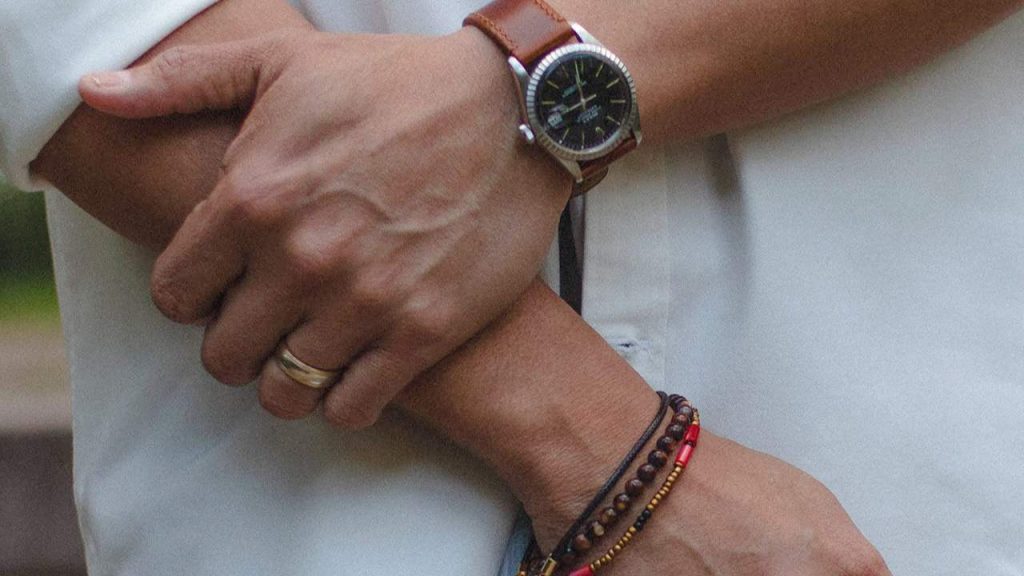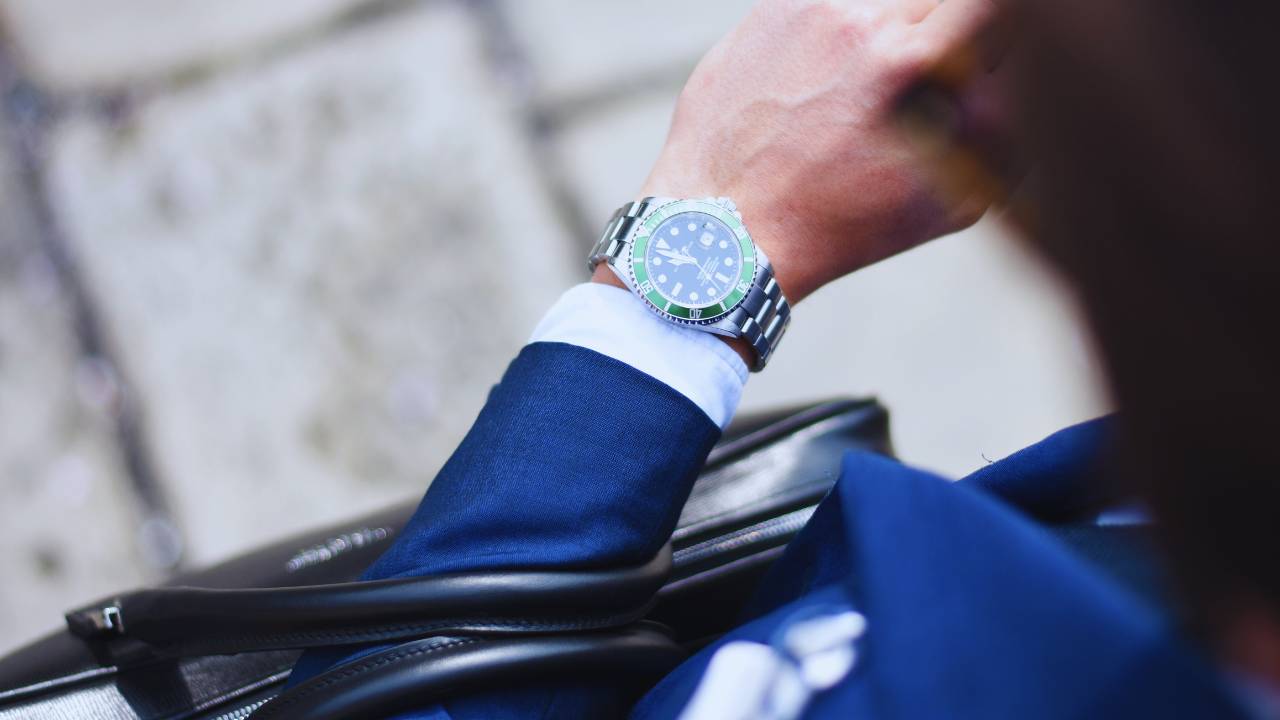Wearing a watch has been a symbol of style, sophistication, and elegance for centuries.
Even modern watches are statement men’s accessories besides being practical timekeepers.
And when it comes to actually wearing a watch, different practices exist.
Some guys wear a watch on the left wrist, others on the right.
So, one may wonder “Which hand do you wear a watch on?”
As a general rule of thumb, you should always wear a watch on your non-dominant hand. If you’re right-handed, you would wear a watch on your left hand. And for lefties, wearing a watch on the right hand is natural.
Also, around 85-90% of the Western population is right-handed, so wearing a watch on the left wrist has become the routine.
Plenty of other nuances exist regarding your choice of hand to wear a hand.
In this article, we’ll delve into such factors, common practices, and unique style trends.
Table of Contents
Wearing a Watch on the Left Wrist
Almost always, you’ll see gentlemen wearing a watch on the left wrist.
Here are a few reasons why 90% of all watch-wearers wear a watch on the left wrist.
It’s Practical
A large proportion of the population is right-handed (around 80-90% Western Population).
Wearing a watch on the non-dominant wrist makes it less likely to interfere with their daily tasks and movements.
Also, more people are active with their dominant hands in things like writing, opening the door, etc.
So, the watch is less likely to get caught on something and damaged when worn on the non-dominant hand.
Also, many luxury and mechanical watches are somewhat heavy. Putting a lot of weight on your dominant hand could be uncomfortable.
So, wearing it on the left wrist seems like a practical choice.
There is some historical aspect to it. Early watches were exclusively worn on a chain around the neck.
However, during World War I, soldiers began wearing them on their wrists for ease of timekeeping while in combat.
It’s said that before the war ended, it became popular for men to wear watches on their left wrists as a symbol of military service.
This tradition has passed on from generation to generation and has become a part of our culture to wear a watch on the left wrist.
Ease in Time-Reading
Most watches contain a knob or buttons on the right side.
If you wear your watch on your left hand, it would be easier to adjust the time or date according to your convenience.

Since most of us are right-handed, our motor skills for precise movements are better developed in our dominant hand.
Hence, adjusting a watch’s time would be easier when worn on the left wrist.
Comfort and Convenience
Wearing a watch on the left wrist is also more comfortable for many people as it fits better.
Our non-dominant hand usually does less work throughout the day, making it less prone to fatigue.
This makes wearing a watch on the left wrist more comfortable, especially for those who wear their watches for extended periods of time.
Additionally, since most people are right-handed, the watch on the right wrist constantly bumps against objects, causing discomfort.
On the other hand, wearing a watch on the left wrist avoids this issue and allows for more convenience in daily tasks.
Good for Watch Movement and Winding
Another reason to wear a watch on the left wrist is that it’s more efficient for the watch’s movement and winding mechanism.
Most watches are designed with their crown or buttons on the right side. It makes it easier to wind and adjust when worn on the left hand.

Wearing a watch on the right wrist could cause strain on the crown or buttons, affecting the watch’s accuracy and longevity.
Similarly, automatic watches use wrist movement to keep the coil moving and ultimately power the watch.
Wearing a watch on the left wrist ensures that it receives enough (but not excessive) movement for optimal functioning.
In comparison, wearing a watch on the right hand makes an automatic watch prone to over-winding, which could damage the delicate internal mechanics.
It’s Looks Stylish and Fashionable
Wearing a watch on the left wrist is generally considered more fashionable.
This may be because most people are right-handed and tend to accessorize their dominant hand more.
By wearing a watch on the left wrist, it stands out as a unique and stylish accessory. It also allows for more versatility in terms of outfit coordination.
For example, if you wear bracelets or other accessories on your right hand, wearing a watch on the left balances out the look.

Additionally, many watch manufacturers design their watches with this in mind, making left-wrist wear more aesthetically pleasing.
Wearing a Watch on Right Hand

Fashion is subjective. And that’s the best part.
Also, there is a saying, “Whatever looks right, it is right.”
You would ironically be wearing a watch on your right hand. What could go wrong? However, wearing a watch on the right hand has certain practical aspects.
Here are when you should do it.
As a Lefty
Left-handed people may find wearing a watch on their right wrist more comfortable.
It’s because the left is their dominant hand, and you wear a watch on the non-dominant hand.
It allows for easier access to the watch’s buttons and crown, making it as practical as other things mentioned above.
If you’re an Athlete
Wearing a watch on the right wrist may be more suitable for athletes or individuals who engage in activities involving their dominant hand.
This is because the watch will not get in the way of movement and may even provide better protection for the watch.
Athletes also tend to sweat more on their dominant hand, and wearing a watch on the right wrist can help avoid any potential damage from moisture.
Making the Watch more Noticeable
Some people prefer their watch to be more visible and prominent on their wrist.
Wearing it on the right hand can accomplish this, as it may stand out more than traditional left-hand wear.
This can also serve as a unique style statement for those bold enough to break the norm of left-handed watch-wearing.
Personal Style
Wearing a watch on the right hand can sometimes be an expression of personal style.
Some fashion-forward individuals may deliberately choose to wear their watch on the right hand, as it adds an unconventional touch to their overall look.
It’s a small detail that can make a big impact and set them apart from others.
David Beckham is a sort leader of the right hand watch club.

Other Prominent figures who are known for wearing their watches on the right wrist include:
- Prince William: The Duke of Cambridge Prince William is often seen wearing his watch on his right wrist.
- Robert Downey Jr.: The “Iron Man” and “Sherlock Holmes” star is a known watch enthusiast and is often photographed with his watch on his right wrist.
- Rafael Nadal: The world-renowned tennis player, renowned for his left-handed play, wears his specially designed Richard Mille timepieces on his right wrist.
- Leonardo DiCaprio: The award-winning actor and environmental activist is often spotted wearing his watch on his right wrist.
- Mark Wahlberg: The actor and former rapper, known for his roles in action films, is also seen wearing his watch on his right wrist often.
Some Unique Watch-Wearing Styles
Apart from choosing the wrist to wear a watch, some unique styles exist among watch wearers.
These include wearing a watch:
- Upside down: This involves wearing the watch with the face towards the palm of the hand instead of facing outward.
- On top of sleeves: Watch enthusiasts have been stacking their watches on their shirt or jacket sleeves for a bold and eye-catching look. Gianni Agnelli made this style popular.
- On the ankle: A recent trend that has gained popularity, wearing a watch on the ankle can be seen as a rebellious and unconventional style choice. Apple watch guys do it (and I hate that).
- Stacked bracelets: Watches can also be worn alongside other bracelets to create a stacked look, showcasing one’s taste in accessories.
Closing Thoughts
In conclusion, the wrist on which a person wears their watch can reveal interesting insights into their personality and preferences.
Whether for practicality or style, the choice of wearing a watch on the left or right wrist is entirely personal.
However, I would advise always wearing a watch on your non-dominant hand. It will be most debonair, and you won’t stand out as a try-hard.

I am George. I am a watch enthusiast as far as I can remember.
My passion for horology extends beyond the surface, delving into the art, history, and precision that make each watch a masterpiece.
